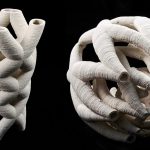Novi Limestone Mechanism
More increasingly than ever has the relevance of waste in this world become important. Quarrying is an inefficient process with most of the waste created going into aggregates. This includes a lot of good stone with some minor faults in it, and it is not economical to cut around those faults. Jack Biltcliffe, in collaboration with ASTUDIO and the Portland Sculpture and Quarry Trust developed Novi which is a 3D print mechanism that has been designed from the ground up to work with the extrusion of limestone slurry.
The objective of this project is to reuse this material in a manner that will help with the regeneration project on the Isle of Portland through a sculptural piece. Through a series of iterative experiments, a limestone paste extrusion process, using Portland stone, was developed as part of a major project for an undergraduate degree at Brunel University London.
The limestone slurry was collected and it hardens completely and mostly stays bound together, however it cracks easily under tension. Initial tests proved difficult as the nozzle would often clog. Therefore, the end of the nozzle was modified to a larger aperture. This allowed some of the larger particulates to pass through the nozzle without clogging it. Once the printer was switched over to an 8mm nozzle, the limestone printed out quite well. Later on in the process, Jack also conducted tests that mixed a ratio of quicklime with the limestone stone.
The SCARA Robot
Earlier on, the Mendel90 desktop 3D printer was used, which had been hacked to adapt a 10ml syringe. One of the limitations with using the current Mendel 90 print mechanism is that you are unable to safely extract prints for drying and they must stay on the bed for over 12 hours until the print can be safely extracted. Therefore, he began to look at alternate mechanisms of printing.
Following the research into tri axial movement mechanisms, a version of a robotic arm seemed a great fit because they are versatile. Further research into robotic arms found that the simplest mechanism most versatile mechanism, giving all 3 axis of movement required, is the SCARA mechanism. The SCARA robot is traditionally used as a pick and place robot in assembly line operations. The two arms work together to recreate the XY positional values. Unlike conventional 3D printers it is not constrained to a square build plate.
Breaking Ground
It is hoped that this project will help with the regeneration happening on the Isle of Portland through the creation of sculptural pieces. Further development is under way to build more ambitious designs and to also explore other practical applications that could impact the architectural industry.
This project was supervised by Dr Eujin Pei and Dr Tony Vilches from Brunel University London, and Emma Flynn from ASTUDIO. Visit Madeinbrunel.com















